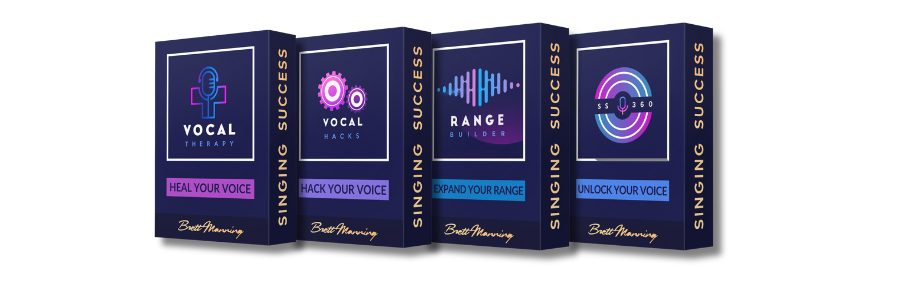
On this episode, you’ll discover:
- how Brett and Chanelle Met
- the differences between Classical vs Commercial Coaching
- the key differences in the way you learned to sing and the NEW way you coach
- plus, you’ll get a BONUS Vocal Demonstration!
Fast-Track Your Success!!

VIP Membership includes:
- Exclusive Facebook Group
- Interact with our vocal coaches–ask them YOUR question
- Live warmups
- Masterclasses and Q&As with Brett Manning and his guests
- SS360 QuickStart Program
- SS360 – The FULL Systematic Vocal Course
- Vocal Hacks
- Range Builder
- Mastering Mix
- Mastering Harmony
- Mastering Vibrato
- Vocal Therapy
- Plus…exclusive content only found here all along the way!
You can struggle on your own, or you can get direct access to the Nashville Coaches who have launched some of the biggest names in the music industry.
Welcome to the Singing Success Show podcast, and my name is Brett Manning. I’m here with Josh Eberle. Look at her with her fluent Chinese! If I say “ni hao ma,” you say “hao ma,” which means she’s doing well. “Hao hyung, how are you doing?” “Well, oh no, ish hyung, I wish.” So it’s for our Chinese audience. We always want to say hi to you and say hello to me. How do you gua? No mankwe ming make was Chinese. So anyway, fun stuff.
Alright, so today I have one of my most distinguished associates, one of the most talented coaches I’ve ever had the pleasure of training. But her story is quite a bit different from most people’s because some people come in here and they’ve been doing commercial music for a long, long time and everything just feels right. They come to the technique and they say, “I just want more range, I want more freedom, more power.” But what happens when you come from a total different genre? So we’re talking about going from classical to commercial singing and is it possible?
So why don’t you, in your most winsome and inviting way, tell us how you came about teaching.
Okay, so way back, growing up, I actually sang a lot of pop. I grew up in Boston, near the city, and I was just a kid of the radio in the ’90s. So, you know, Mariah Carey, Whitney Houston, all the greats. But back then, even as a kid, I knew that there was always this ceiling. So I would just belt as high as I could, and then I’d just drop out. And I never could find the answers anywhere. No one could give me the answer of how to get over that.
Time went on, and I went to college for singing. And most times when you go to college for singing, it’s very classically oriented. So I was trained a lot in how to sing in my head voice. I went from having this big chest voice growing up to now this very big head voice.
After I got done with college, I actually ended up getting my master’s degree in vocal performance. I decided, “Well, I don’t want to sing in an opera house, so what do I do now?” And where I found the joy that I wanted to be singing was in the church. And sometimes I would get solos, and they had a pretty extensive range. But I literally would have this conundrum of, “Where do I put this? Do I sing with this big chest voice that I have, or do I sing with this classical opera sound that I have?” And it was just frustration after frustration.
I started auditioning for shows that started coming out probably about 10 years ago, like The Voice, American Idol, America’s Got Talent. I would always get so far within these auditions, I would always get to right before the big celebrity judges. I even one time got flown out to LA because I had gotten a callback from one of the videos I had done. So I knew that I had talent, I knew that there was something there, but still I kept meeting this roadblock every time I would go to these auditions. I would always get told the same thing: “Your voice is too pretty, it’s too trained, it’s too classical.” And it was just frustration after frustration.
The last audition that I went to was for Disney, and I thought, “Naturally, I can do Disney. The head voice will lend itself to this.” But even still, same thing. I got the callback, went to the final audition, and this is the turning point that changed my life. The casting director, after I sang the song, looked at me and said, “It’s pretty, but I want you to sing it a different way.” And it was in that moment, everything had just come to a head, and I just said, “I don’t know another way to sing this.” I felt disabled with all the training that I had, with all the knowledge, with all the time and money I had spent. I felt like I still couldn’t do what I wanted to do with my voice.
So I went to the casting director after, and he said, “You need commercial-style voice lessons, more voice lessons.” I thought, “I’ve had plenty of voice lessons.” And he said, “No, they need to be in a commercial style.” So I reached out to a friend who had been on American Idol, and I said, “I don’t have time to waste any more time or any more money. I need the best. I need you to give me, I will drive anywhere, I’ll fly anywhere. I need you to give me the best.” And he gave me the number to Brett Manning. I met Brett, and my first lesson was with one of his associate coaches. In my first lesson, I was hitting a high B-flat in a mix voice, this part of my voice that I had never accessed before. I remember leaving the voice lesson and calling my mom and saying, “I found it, Mom. I found the key that unlocked my voice.” And that was the beginning of the end.
The biggest difference from classical to this commercial style is in classical, a lot of emphasis is put on singing in the head voice and singing into the mask. That never really made sense to me. It was kind of lifting your lip a little bit and sending everything forward, but then the next statement was, “But stay out of your nose.” The presence of nasality was frowned upon because it’s an ugly sound. So it was kind of left trying to find this place, but not being in my nose, but not being too much in my head.
In commercial and in Brett’s method, pharyngeal is the biggest difference, where it is just going to the fullest extent of your pharyngeal resonance, just this primal sound that existed ever since you were a baby. So that’s probably one of the biggest distinctions. In classical, it’s head voice and singing into the mask. In commercial, it’s accessing pharyngeal resonance and being able to use all the elements of your voice, not being limited in what you can use.
I didn’t lose anything from my classical training; I gained a better understanding of where I can use it. Classical training felt like third gear; I always had to pull that third gear down. I probably had teachers who said, “Don’t ever use chest voice, it’s vulgar and it’s horrible.” But great classical females sing in their chest voice, and great classical male singers can easily translate it into what we’re doing here in commercial singing. We talk about blending head and chest voice, and the amazing thing is that you end up with, if this is chest and this is head, you can lean a little heavier into the head or a little heavier into the chest on the same note.
When I first started working with Chanel, I noticed she could hit notes effortlessly. We didn’t talk about having her sing, but it’s the idea that we get to a place where levels of expectation create levels of professionalism. I expect it from her, and she can do it. So thank you again, Chanel Gaytan, for joining us on the show.






